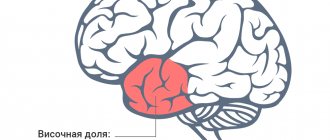Our brain is a complex mechanism that is responsible for performing various tasks. Essentially, it is a biological computer in which physiological and psychological processes, such as memory, occur. Most people confuse or interchange the concepts of “memory” and “memorization.” However, this is a misconception. Memorizing information is the imprinting of specific material; if we continue the parallel with the computer, then it is writing data to the hard drive. This article is devoted to this property of memory.
- Types of memorization
- The main conditions for successful memorization
- Some facts about memorization
Loci method
The name of this method comes from the Latin word locus - “place”. It also goes by a number of other names: spatial mnemonics, memory palace, mind palace, mental walk.
It is generally accepted that the method of loci originated in ancient Rome thanks to orators who had to keep all the information in their memory for many hours of speeches. The essence of the method is visualization, linking facts that need to be remembered to well-known locations. Facts can include anything: foreign words, a shopping list, people’s names, etc.
How does the method of loci work? Imagine that you are standing in your home (memory palace). Walk through the house mentally, taking note of its distinctive features—they can be used to store information you want to remember. Each stop on your way will be the very “locus” to which you can attach an idea or object. For example, the front door can be one locus, the bedside table in the hallway can be a second locus, and the lamp in the living room can be a third. If you need to remember a word, create an association between that word and one of the objects in the house. Record this in your head. When you think about your memory palace, you will remember not only the route, but also the objects associated with the locations.
Some facts about memorization
The art of successful memory retention is, to some extent, work. However, there are specific conditions for this. Let's look at some patterns of memorization.
- Trivial events in life, which leave a particularly vivid impression, are stored in the head immediately and for a long time, and years later are retained in the mind clearly and clearly.
- Events that do not make a strong impression, even if repeated several times, will be remembered partially or not at all.
- There is the concept of “edge effect,” in which the beginning and end of a memorized row are better recreated.
- The number of repetitions needed for memorization is reduced in the case of increased attention to the memorized information. However, lack of attention cannot be compensated for by increasing the number of repetitions.
- The material in which the individual is especially interested will be remembered without effort. In adulthood, this pattern appears more clearly.
- Extraordinary and surprising impressions are recorded better than common and ordinary ones.
- The new experience gained by a person will not remain isolated in memory. By entering into an associative connection with other impressions, it can change or influence them in some way.
So, the processor located in a person’s head is an incredibly complex device that performs various tasks. We tried to highlight one of these problems in the article. Fulfilling specific conditions, comprehending the information received, weaving it into logical networks, as well as repeating what has been learned promise to fix the necessary knowledge in memory.
Mnemonics
This method is a set of techniques and methods that simplify the memorization of various information. It usually requires more effort to use effectively, but is better used in situations where you need to remember things like lists or structures. For example, if you need to remember a list of medications of a certain type, mnemonics will help you do this better than other methods.
Mnemonics is based on the formation of associative series and sequences when a person replaces abstract objects with real concepts. The main thing is to use bright, interesting associations.
In mnemonics, there are several most well-known techniques:
- Acronym: You make a combination of letters that “encrypts” the complete information for memorization.
- Acrostic: You create a poem in which the initial letters of the lines form a word.
- Keywords: You highlight key words in phrases. By remembering them, you restore the entire phrase in your memory.
- Rhyming: You make up rhymes to help you remember words or numbers.
- Image-name technique (suitable for remembering names): you come up with any clear connection between a person’s name and his physical characteristics.
- Chaining: You create a story in which the word or thought you want to remember causes a chain reaction and draws the next words with it.
Chunking method (crushing, fragmentation)
This method involves combining several elements that need to be remembered into one small group. Many people use it when trying to remember phone numbers or bank account numbers, but this method can be used for other types of information. The chunking approach is often reflected in the way we write phone numbers - with a dash. We do it this way in order to better perceive a set of numbers and remember them faster. Is there a difference between the perception of a set of numbers: 89265660000 and 8-926-566-0000? Of course have.
The key principle that makes this technique work is the combination of items based on semantic encoding, that is, items are placed into small groups according to context or some kind of pattern.
For example, some may group their grocery list alphabetically, others by food type. In any case, this method is only successfully implemented when you identify the most natural patterns for yourself and follow them.
Classification of types of memory. Characteristics of memory processes
Marina Isagulova
Classification of types of memory. Characteristics of memory processes
Classification of types of memory . Characteristics of memory processes
Classification according to the dependence of its characteristics on the characteristics of memorization and reproduction activities. In this case, individual types of memory are distinguished in accordance with three main criteria:
1. according to the nature of mental activity that predominates in the activity, memory is divided into motor, emotional, figurative and verbal-logical
2. according to the nature of the goals of the activity - voluntary and involuntary
3. according to the duration of fastening and preserving materials - short-term, long-term and operational.
Motor memory is the memorization , preservation and reproduction of various movements and their systems. It participates in the formation of motor, in particular labor and sports skills. Without memory for movements, we would have to learn to carry out the appropriate actions every time [34].
Emotional memory is memory for feelings . It is important in the life and activities of every person. experienced and stored in memory act as signals that either encourage action or deter actions that caused negative experiences in the past. The ability to sympathize with another person, to empathize with the hero of a book, is based on this type of memory . on emotional memory : what causes emotional experiences in a person is remembered by him without much difficulty and for a longer period.
Figurative memory is the memory of ideas , pictures of nature and life, as well as sounds, smells, tastes. It is visual, auditory, tactile, olfactory and gustatory.
Verbal-logical memory - its content is our thoughts. The main role in this type of memory belongs to the second signaling system. Based on the development of other types of memory , verbal-logical memory becomes leading in relation to them, and the development of all other types of memory . This type of memory is characterized by the fact that a person who has it can quickly and accurately remember the meaning of events, the logic of reasoning or any evidence, the meaning of a text being read, etc. He can convey this meaning in his own words, and quite accurately. This type of memory is possessed by scientists , experienced lecturers, university teachers and school teachers.
Voluntary memory is a memorization process that requires volitional efforts.
Involuntary memory is memorization and reproduction that occurs automatically and without much effort on the part of a person, without setting a special mnemonic task for himself.
Short-term memory is a way of storing information for a short period of time. The duration of retention of mnemonic traces here does not exceed several tens of seconds, on average about twenty. In short-term memory, not a complete, but only a generalized image of what is perceived, its most essential elements, is stored. This memory works without a preliminary conscious intention to memorize, but with an intention to subsequently reproduce the material. Short-term memory is characterized by such an indicator as volume. It is on average equal to 5 to 9 units of information and is determined by the number of units of information that a person is able to accurately reproduce several tens of seconds after this information has been presented to him once.
Short-term memory is associated with the so-called actual human consciousness. From instant memory, only that information that is recognized, correlates with the current interests and needs of a person, and attracts his increased attention gets into it [33].
RAM is called memory , designed to store information for a certain, predetermined period, ranging from several seconds to several days. The storage period of information in this memory is determined by the task faced by a person, and is designed only for solving this problem. After this, information may disappear from RAM . This type of memory, in terms of the duration of information storage and its properties, occupies an intermediate position between short-term and long-term. Random access memory , "related"
short-term, allows you to save a trace of the image only for performing current actions
(operations)
.
For example, sequentially removing information symbols of a message from the display screen and holding it in memory until the end of the entire message.
Long-term memory is memory capable of storing information for an almost unlimited period. Information that has entered long-term memory can be reproduced by a person as many times as desired without loss. Moreover, repeated and systematic reproduction of this information only strengthens its traces in long-term memory . The latter presupposes a person’s ability, at any necessary moment, to recall what was once remembered by him. [38]. When using long-term memory , remembering often requires thinking and willpower, so its functioning in practice is usually associated with these two processes .
Let us now consider some features and relationships between the two main types of memory that a person uses in everyday life: short-term and long-term.
The capacity of short-term memory varies from person to person . It characterizes a person’s natural memory and shows a tendency to be preserved throughout life. First of all, it determines mechanical memory and its capabilities. Associated with the peculiarities of short-term memory , due to its limited capacity, is a property called substitution. It manifests itself in the fact that when the individual limited capacity of a person’s short-term memory , newly arriving information partially displaces the information stored there, and the latter irretrievably disappears, is forgotten, and does not end up in long-term storage. This, in particular, happens when a person has to deal with information that he is not able to fully remember and which is presented to him continuously and sequentially.
Short-term memory plays a big role in human life. Thanks to it, the largest amount of information is processed, unnecessary information is immediately eliminated and potentially useful remains. As a result, there is no information overload of long-term memory with unnecessary information, and a person’s time is saved. Short-term memory is of great importance for organizing thinking; the material of the latter, as a rule, are facts located either in short-term memory or in operative memory close in its characteristics .
Depending on the goals of the study, the concepts of genetic (biological, episodic, reconstructive, reproductive, associative, autobiographical memory) .
Genetic (biological)
memory is determined by the mechanism of heredity. This is “
memory of centuries ,
” a memory of the biological events of the vast evolutionary period of man as a species. It preserves a person’s tendency to engage in certain types of behavior and patterns of action in specific situations. Through this memory , elementary innate reflexes, instincts and even elements of a person’s physical appearance are transmitted.
Episodic memory concerns the storage of individual pieces of information with the recording of the situation in which it was perceived (time, place, method)
. For example, a person, looking for a gift for a friend, outlined a clear route around retail outlets, recording suitable items by location, floors, departments of stores and the faces of the salespeople working there.
Reproductive memory consists of repeated reproduction by recalling an original previously stored object. For example, an artist draws a picture from memory (based on recollection)
taiga landscape, which he contemplated while on a creative business trip.
It is known that Aivazovsky created all his paintings from memory .
Reconstructive memory consists not so much in the reproduction of an object, but in the procedure for restoring a disrupted sequence of stimuli in its original form. For example, a process engineer restores memory processes for manufacturing a complex part.
Associative memory is based on any established functional connections (associations)
between memorized objects. A man, passing by a candy store, remembered that at home he was instructed to buy a cake for dinner. [25].
Autobiographical memory is memory for events in one’s own life (in principle, it can be classified as a type of episodic memory ).
All types of memory belonging to different classification bases are closely interrelated. Indeed, for example, the quality of short-term memory determines the level of functioning of long-term memory . At the same time, objects perceived simultaneously through several channels are better remembered by a person.
Characteristics of memory processes
Memorization
The initial form of memorization is involuntary, i.e. memorization without a predetermined goal, without the use of any techniques. This is a simple imprint of what was affected, the preservation of some trace of excitation in the cerebral cortex.
Much of what a person encounters in life is involuntarily remembered: surrounding objects, phenomena, events of everyday life, people’s actions, the content of movies, books read without any educational purpose, etc., and although not all of them are remembered equally well . What is remembered best is what is vitally important for a person: everything that is connected with his interests and needs, with the goals and objectives of his activities. Even involuntary memorization is selective , determined by attitude to the environment.
Involuntary memorization reflects constantly occurring, repeating events (for example, meeting students several times at school, the teacher remembers some of them, although he does not teach them).
The leading form of memorization in humans is voluntary. It is characterized by the fact that a person sets a specific goal - to remember what is intended, and uses special memorization techniques. Voluntary memorization is a special and complex mental activity subordinate to the task of remembering and includes a variety of actions performed in order to better achieve this goal [24].
When memorization is associated with certain difficulties, consolidation of the material requires special techniques, special organization (repetitions, etc.)
;
it then takes the form of specially organized memorization - memorization, which is usually accomplished in a complex learning process .
So, for example, poems, definitions, laws, formulas, historical dates, words of a foreign language, etc. are memorized. Of primary importance is the question of the dependence of memorization on the nature of the activity during which it is performed. Theoretically, central to the problem of memorization is the question of the relationship between voluntary and involuntary memorization, i.e., memorization that constitutes the direct goal of the subject’s action, and memorization that occurs unintentionally in the course of an activity that sets itself a different goal. At first glance, the advantages of voluntary memorization are obvious. However, everyday observations still indicate that most of what we remember in life is remembered by us involuntarily, without special intention, and much of what we did not try to remember at all, we remember in such a way that we can never forget, - even if they wanted it.
Preservation
Retention is a more or less long-term retention in memory of information obtained through experience. Preservation as a memory process has its own laws. It has been established that conservation can be dynamic and static. Dynamic storage manifests itself in RAM , and static storage manifests itself in long-term memory. With dynamic conservation, the material changes little; with static conservation, on the contrary, it must undergo reconstruction and processing.
Reconstruction of material stored by long-term memory occurs under the influence of information that is continuously received again. Reconstruction manifests itself in various forms: in the disappearance of some details and their replacement by other details, in a change in the sequence of the material, in its generalization.
Previously memorized knowledge interacts with newly acquired ones: they enter into new connections (they are associated, clarified and differentiated, generalized and recoded. The experience stored by consciousness is constantly changing and enriched. Only what has been memorized as an independent integral statement is preserved and reproduced unchanged.
The preservation of information and its modification can be judged only by the following two memory processes - recognition and reproduction.
Recognition and reproduction
To recognize is to recognize: recognition is an act of cognition. In recognition, the activity of correlating, comparing the sensory qualities of the image arising in the process of perception with the object, which is already contained in perception, stands out from perception and comes to the fore. Any perception, as an act of cognition, contains, in a more or less hidden form, a correlation, a comparison of the image that appears in perception with an object. When it is not this activity that is represented in consciousness, but its result, there is perception; when this activity comes to the fore in consciousness, the whole process is presented as recognition. (The activity of correlation and juxtaposition is especially represented in palpation; therefore, palpation of an object usually easily passes from the plane of perception to the plane of recognition.)
Recognition can occur on several levels. Its most elementary primary form is more or less automatic recognition in action. This first stage of recognition manifests itself in the form of an adequate response to the primary stimulus.
The next step is the forms of recognition, which are associated with a feeling of familiarity, without the possibility, however, of identifying a recognized object with a previously perceived one. I may feel that this object is not the one or that the word that came to me is not the one I am looking for, but at the same time I am not able to define this object or name the right word. Only in relation to this type of recognition can the explanation that W. Wundt put forward for recognition in general be applicable, when he argued that we recognize things not so much by their signs, but by the feelings that they arouse in us; Following motor reactions or simultaneously with them, emotional moments begin to play a role in recognition, which create, as it were, emotional overtones of consciousness.
Forgetting
Along with the above processes, forgetting is no less important , necessary and natural. It is expressed in the inability to remember or in erroneous recognition or reproduction. The physiological basis of forgetting is certain types of cortical inhibition that interfere with actualization (revival)
temporary nerve connections.
Forgetting is useful and organically connected with the formation of personal experience. All that information that is not relevant, is not repeated, is not reproduced by a person even on an internal level must be forgotten. Without forgetting, both personally significant and random information, both correctly and incorrectly learned knowledge, would coexist in consciousness. Unpleasant, difficult emotional experiences would be constantly in the mind, depressing a person’s normal life.
The founder of psychoanalysis, S. Freud, paid great attention to the analysis of the mechanisms of forgetting that occur in everyday life. He wrote that one of these very common mechanisms is “disruption of the train of thought by the force of internal protest emanating from something repressed.” He argued that in many cases of forgetting, it is based on the motive of reluctance to remember. One can argue with such a statement, but one should hardly deny that such a forgetting mechanism does not work in life.
Examples of motivated forgetting, according to Z. Freud, are cases when a person involuntarily loses, puts somewhere things related to what he wants to forget, and forgets about these things so that they do not remind him of psychologically unpleasant circumstances.
The tendency to forget unpleasant things is indeed widespread in life. Especially often, such motivated forgetting of unpleasant intentions and promises manifests itself in cases where they are associated with memories that give rise to negative emotional experiences.
List of used literature
1. Blonsky, P. P. Memory and thinking : In the book. fav. psycho. prod. [Text] / P. P. Blonsky. – M.: Education, 1994. –68.
2. Memory . / Rep. ed. I. N. Korzh. - M: Nauka, 1990. - p. 216
3. Leontiev A. N. Development of higher forms of memorization // Psychology of memory / Ed . Yu. B. Gippenreiter and V. Ya. Romanova. - M: CheR, 1998. - p. 816
4. Lyaudis, V. Ya. Memory in the process of development [Text]/V . Ya. Lyaudis. – M.: Moscow University Publishing House, 1976. – 253 p.
5. Mukhina V. S. Age psychology / V. S. Mukhina. – M.: Academy, 1998. – 456 p.
6. Nemov R. S. Psychology: Textbook. for students higher pedagogical educational institutions: In 3 books. – 4 – ed. — M.: Humanist. ed. VLADOS center, 2003. - book 1; General fundamentals of psychology. – 688 p.
7. Psychology of memory / Ed . Yu. B. Gippenreiter and V. Ya. Romanova. - M: CheR, 1998. - p. 816
8. Rogov E.I. Handbook for a practical psychologist: Textbook: In 2 books - Moscow: Vlados - Press, 2001.
9. Rogov E. N. Handbook for a practical psychologist: Textbook: In 2 books. / E. N. Rogov. Book 1: The system of work of a psychologist with children of different ages. – M.: Vlados-press, 2002. – 384 p.
10. Rubinstein S. L. Fundamentals of general psychology - St. Petersburg. 2009.
11. Smirnov A. A. Voluntary and involuntary memorization // Psychology of memory / Ed . Yu. B. Gippenreiter and V. Ya. Romanova. M: CheR, 1998. – P. 816.
12. Smirnov A. A. Voluntary and involuntary memorization // Psychology of memory / Ed .
Yu. B. Gippenreiter and V. Ya. Romanova. M: CheR, 1998. – P. 816.
Spaced Repetition
The essence of the method is that a person repeats learned information according to certain, constantly increasing intervals. This method even has a specific formula: Y=2X+1, where Y means the day when the information begins to be forgotten, and X is the day of the last repetition. Thus, if you learned information, for example, a week ago, then you will need to repeat it after 8 days. In this case, the potential of the interval is equal to infinity.
The spaced repetition technique is often used in conjunction with flashcards. The most common example: when learning a foreign language, you make cards with unfamiliar words and then repeat them at certain intervals.
Storytelling method
According to research, our brains love stories so much that a good story can trigger the release of oxytocin, a hormone that increases empathy in people.
Stories embrace all the qualities of information that make our brains love and remember it: bright and colorful images, compelling storylines. The advertising industry exploits these opportunities all the time, but you too can use storytelling to help you remember important information. Moreover, it is quite simple.
The idea of the method is that you create different storylines that include elements necessary for memorization. As a result, these elements are combined in sequences, and stories are created that the brain better assimilates and perceives.
The accuracy of the narrative matters little in this case. As with the method of loci, in the case of storytelling, it is important to organically fit the information that interests you into the thread of the narrative.
The main conditions for successful memorization
The art of easily storing any information in memory is not an innate gift. Attention, repetition and association are three factors that influence the effectiveness of memorization.
To form a memory, study the material with special attention. When mastering any science, it is important to follow the rule of a smooth transition from old to new. Here the snowball effect works: with insufficiently mastered previous knowledge, a person cannot perceive new information with proper attention.
It is known that repetition of material leaves a deep imprint in the memory. However, rote memorization without comprehension will be useless, since such information will soon be forgotten. It is also necessary to periodically repeat the studied material to consolidate knowledge in memory. Please note that repetition at long intervals is useless, so you need to return to the material after a short period of time.
The secret to a perfect memory is to create varied and innumerable associations with the information you remember. Educational material that is mastered gradually, associated with other phenomena and discussed more than once, is easily recreated and stored in memory for a long time.
Another rule of thumb: what is learned slowly is retained in memory for a long time. And, accordingly, what is studied quickly is quickly removed from consciousness. An obvious example is that students memorize tickets before exams, but after the exam they soon forget the material. The time allocated for memorization is important, since the acquired knowledge has time to enter into associative connections, and this determines its long-term presence in consciousness.











